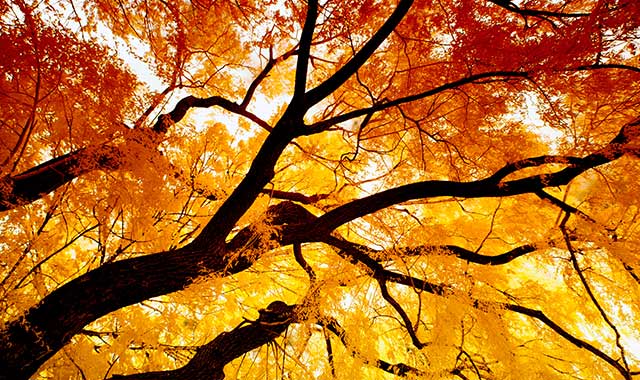This time of year is perfect for planting new trees to fill your yards or your barren parkways. Here are a few things to keep in mind as you select the perfect new tree.

As you drive through a beautiful neighborhood with stunning, mature trees strategically placed along roads, do you ever stop to think about the people who planted them?
Sean Ducey does.
“Everybody has a memory of being in a wooded neighborhood with towering, majestic trees – and loving it,” says Ducey, nursery manager at Whispering Hills Garden & Landscape Center, 8401 Illinois Route 31, Cary. “Someone planted those trees that we enjoy today. The newer subdivisions are nice, but they’re just not the same, because they lack mature trees. We need to plant them for the future.”
Fall is a great time to plant most any kind of tree, right up until the ground freezes. The only exception is an evergreen tree, which does better when planted in spring, summer or early fall, says Ducey.
“Since it doesn’t lose leaves and go dormant, as deciduous plants do, it continues to lose water,” he explains. “Planting earlier in the season allows it to establish a better root system and retain the moisture it needs.”
By contrast, deciduous trees don’t mind going into cold ground.
“They’re asleep, anyway, so they just ride out the winter in a dormant state and then wake up during the spring thaw, ready to grow,” says Ducey.
High-quality trees are expensive, so consumers should do their homework, “just as you would do when you buy a car,” says Ducey. “The most common mistake we see is planting the tree too close to the house or in too small a space to allow for growth.”
Jon Carlson, owner of J. Carlson Growers, 8938 Newburg Road, Rockford, couldn’t agree more.
“It’s hard for people to conceptualize what a plant will look like after many years of growth,” says Carlson. “But it’s much, much better to choose the right plant for the space, in the first place, than to try to prune it into submission later. Trees grow. That’s what they’re supposed to do. Part of the beauty you enjoy in a tree is seeing its natural shape. Especially in winter, when leaves have dropped, a tree can be like a beautiful sculpture, a piece of artwork. But not if it’s been all hacked up.”
Thanks to breeding programs that have been in place for decades, many trees are available in a range of sizes, today.
“For example, these days you can buy a beautiful, scab-resistant flowering crabapple tree in sizes that range from 4-by-4 feet to 20-by-20 feet,” says Ducey.
By all means, plant large trees if you have space to accommodate their mature size. Ducey is a big fan of burr and white oak trees, both native to our natural landscape. “They’re beautiful in every season and add something majestic to our landscape,” he says. Other deciduous trees that do well in our region (and reduce cooling costs to the homes they shade) include maple, sycamore, linden, locust and hickory trees. Ash trees are not a good choice, right now, due to an infestation of emerald ash borers that’s decimating ash populations across the nation.
Large trees shouldn’t be planted too near a house or too close to overhead wires. No one enjoys seeing a row of trees that have been hollowed out in the middle to accommodate power lines. Still, we all value our electrical service.
The solution is to plant trees below power lines that crown at less than 25 feet tall, says Carlson. He recommends the following nine varieties for their flowering and fruiting characteristics, compatibility with our climate and shorter stature.
1. Serviceberry. They have attractive bark, spring flowers, fall color and small fruits enjoyed by wildlife.
2. Eastern Redbud. This small, springtime flowering tree usually has multiple trunks and graceful ascending branches. Its reddish-purple spring color is stunning; leaves turn yellow in fall.
3. Japanese Tree Lilac. An attractive upright habit and strong salt/urban tolerance make it ideal for lining city streets. It has large, creamy-white flowers in springtime.
4. Amur Maple. This slow-growing tree with glossy dark-green leaves seldom surpasses 20 feet in height. Some varieties offer stunning autumn color.
5. Susan Magnolia. This tree tops out below 20 feet and offers large, pink spring blooms. Royal Star is another good variety, and has white blossoms.
6. Japanese Red Maple. With beautiful red leaves that “light up” in sunlight, this tree can spread out as much as 20 feet but won’t grow taller than 25 feet.
7. Hawthorn. Carlson recommends a variety like ‘Thornless Cockspur’ or ‘Crimson Cloud’ that won’t exceed 20 feet tall. Enjoy attractive flowers, fruit and nice growth habits.
8. Pagoda Dogwood. This beauty has fragrant, creamy-white flowers in early spring, blue-black fruit on red stems in summer, red/purple foliage in fall and an attractive horizontal layered form.
9. Flowering Crabapple. Many kinds are suitable for planting below power lines; check with your gardening expert to learn about heights for each. Known for their explosion of spring pink or white blossoms and colorful fruits, newer varieties are bred to resist the scab that once plagued this Midwest favorite. Carlson recommends ‘Prairiefire,’ ‘Redbud Crabapple’ and ‘Spring Snow Crabapple,’ among many others.
No matter what kind of tree you’re planting, there are ways to improve its odds of survival.
“Because of our building practices around here, our soil tends to be very heavy clay,” Ducey explains. “Builders scrape off the top layer of soil and leave only enough to grow grass. So, when we plant trees for customers, we make a larger-than-needed hole and amend the soil so new roots have something to grow into.”
Many garden centers will deliver and plant a tree for you, charging roughly half of the cost of the tree for this service. If you decide to do the planting yourself, be sure to take the same precautions as professionals (see box at left.)
Although trees mostly take care of themselves once planted, there are things to consider. “Careless use of lawn mowers and string trimmers can cause severe injury to trees,” says Carlson. “It’s also important to water correctly. Too much or too little can stress trees. And poor drainage caused by soil compaction prevents root growth.”
While trees require proper nutrients to sustain growth, resist applying too much fertilizer. Soil analysis can pinpoint deficiencies before plant health is affected. Find a partial list of soil testing labs at urbanext.illinois.edu/soiltest, or call your local university extension service.
A well-chosen, well-located tree can be a source of great joy not only to you and your family, but also to generations to come. Be sure to consult a locally owned garden center to get the best possible advice before planting your next tree. Why not plant for the future, this fall?
8 Steps to Planting the Right Tree in the Right Place
1. Planting Site
Usually, plants grow as wide as they grow tall. Choose a site where they won’t grow into buildings or overhead wires and won’t interfere with car and pedestrian traffic.
2. Preparing the Soil
Feed poor soils by adding one part compost to four parts top soil.
3. Depth
Hole depth should equal root ball height. Hole width should be three times root ball diameter, with sides tapered in. Caution: Avoid underground utilities when digging! For free utility locating service, call 811, which is JULIE Illinois.
4. Prune
Prune damaged roots back to healthy tissue and broken branches back to branch collars. Remove all wire, string and plastic from root ball.
5. About Staking
Staking retards strong growth. Use stakes only to support plants until stabilized. Use protective material around trunk to prevent plant damage.
6. Planting Depth
Place plant in hole so top of root ball is at grade, not below. Gently firm soil around roots. Create ridge of soil around rim of hole to retain water.
7. Mulch
Use a 2- to 4-inch layer to conserve moisture and protect roots. The best choices are shredded bark or aged wood chips. Don’t over-mulch.
8. Water
Water once a week, more frequently when weather is very dry. Keep soil moist, not soaked. Water the area directly above root ball.
Source: J. Carlson Growers




















































